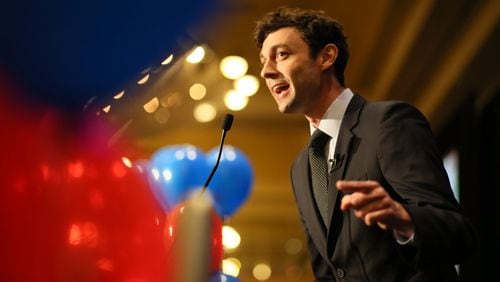Jon Ossoff, the Democratic candidate who finished first in the initial round of voting in Georgia's historically Republican 6th congressional district, recently aired an ad portraying himself as an opponent of unnecessary government spending.
Ossoff, a former congressional aide, said in part, "We need stricter oversight and tougher penalties. They need to be held accountable. And there's $16 billion in duplicate programs. That can be cut."
We wondered where that $16 billion figure came from, so we did some due diligence.
The Ossoff campaign sent us to a report published every year since 2011 by the Government Accountability Office, the respected, nonpartisan, investigative arm of Congress. The report, which is mandated by law, is designed to point out programs, offices and practices that duplicate other government functions or fail to provide value for the taxpayer.
Ossoff's campaign said the $16 billion figure came from several line items in the GAO report that he has reviewed and believes can be eliminated in short order without significant harm. Here's a list. (For the full description of these programs, you can refer to the GAO report.)
• Consolidate federal data centers: Save $5.4 billion.
• Use “strategic sourcing” at the Defense Department: Save $4 billion.
• Expand joint basing at the Defense Department: Save $2.3 billion.
• Improve “demonstrative spending” at the Centers for Medicare and Medicaid Services: Save at least $2 billion.
• Improve management of oil and gas resources on federal lands: Save $1.7 billion.
• Consolidate mobile communications: Save $388 million.
• Improve oversight of state spending under the Centers for Medicare and Medicaid Services: Save at least $200 million.
These seven items add up to about $16 billion.
That said, it’s worth noting that only some, not all, are duplicative in the strictest sense; with some of these recommendations, the GAO is calling for improved oversight or management. Also, the $16 billion figure doesn’t include all recommendations in the GAO report — or even all of those that stem specifically from programs or efforts GAO deemed duplicative.
Meanwhile, the report includes a wide range of other recommendations Ossoff has not explicitly said he supports. (We excluded recommendations where GAO was unable to provide a specific dollar figure.) They include:
• Timely children’s disability reviews to ensure that only eligible children receive Supplemental Security Income benefits: Save $3.1 billion over five years
• Better data to better enforce offsets and ensure benefit fairness in Social Security. Save $2.4 billion to $7.9 billion over 10 years.
• Subsidy limit for crop insurance premiums for individual farmers: Save $2 billion annually
• Rescinding the U.S. Enrichment Corp. Fund: Save $1.6 billion
• Marketing the Energy Department’s excess uranium: Secure $1 billion in additional revenue.
So when Ossoff says “there’s $16 billion in duplicate programs” that could be cut, he’s actually undercounting. GAO found at least $13 billion in additional specified savings that Ossoff did not allude to in the ad.
A final note: $16 billion is a fairly small fraction of federal spending, which is about $4 trillion for fiscal year 2017. Even if you exclude mandatory spending on such programs as Social Security, Medicare, Medicaid and interest on the debt, the government still spends more than $1 trillion a year on “discretionary” programs.
Our ruling
Ossoff said that in the federal government, “there’s $16 billion in duplicate programs. That can be cut.”
There are indeed $16 billion in cuts recommended by a nonpartisan arm of Congress, though not all are examples of duplication. The actual universe of cuts GAO offered is even higher. — somewhere north of an additional $13 billion.
The statement is accurate but needs clarification, so we rate it Mostly True.
In the federal government, “there’s $16 billion in duplicate programs. That can be cut.”
— Jon Ossoff on March 30 in a campaign ad







